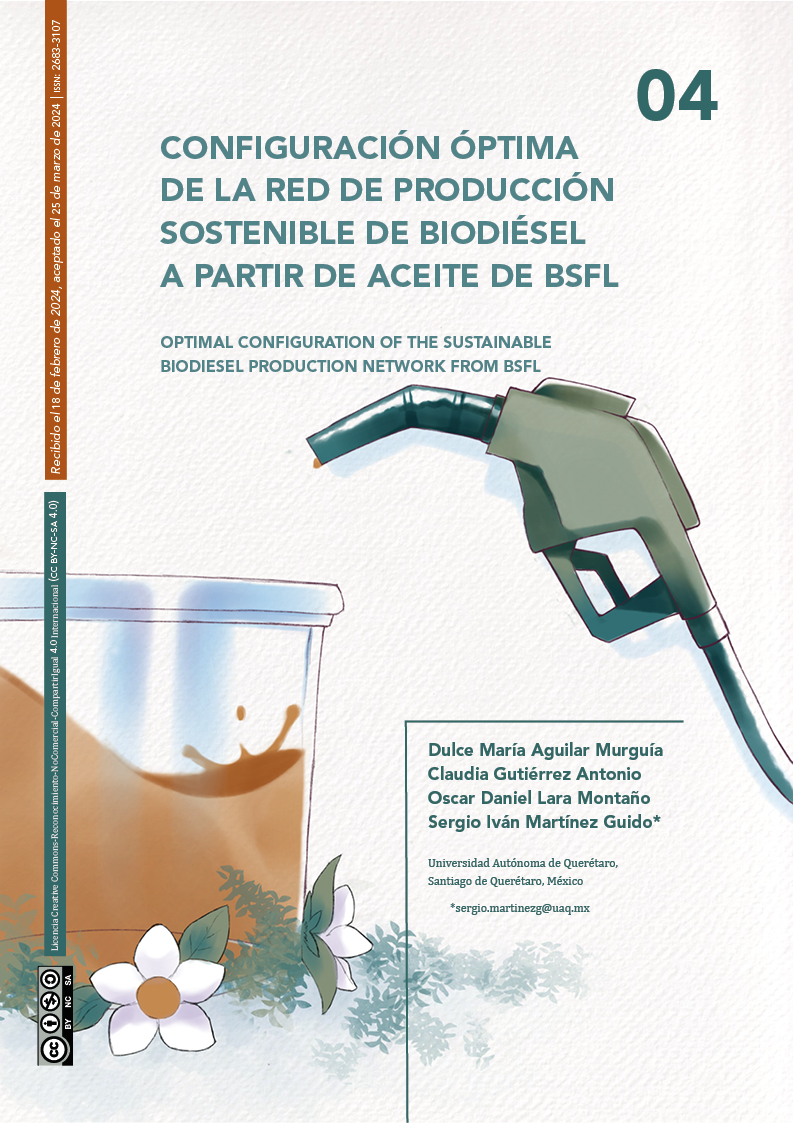Abstract
Over the past decade, de-carbonization alternatives have been proposed in the transport sector, including using electric vehicles and biofuels in internal combustion engines. Biodiesel has proved to be one of the alternative biofuels of great interest since it can be used in mixtures with its fossil counterpart. However, all installed production plants use animal and vegetable oils as raw materials; these inputs impact the total production cost, up to 1.5 times the cost of conventional diesel. Faced with this, the use of black soldier fly larval oil has been proposed, given its high-fat content. In addition, these insects can feed on diverse types of organic waste; these residues are transformed into biomass with a high content of lipids (35-40%). In this context, this paper proposes the design and configuration of a supply chain capable of responding to the demand for fuel at the national level. For this purpose, a mathematical optimization model was formulated that considers aspects of production nodes' supply, transport, distribution, storage, and location. Performance maximization and emission minimization are established as target functions.
References
K. Im-orb, A. Arpornwichanop, and L. Simasatitkul, “Process intensification approach for design and optimization of biodiesel production from palm fatty acid distillate,” Biotechnology Reports, vol. 30, p. e00622, 2021.
D. M. Matos-Ríos, J. M. Ponce-Ortega and C. Gutiérrez-Antonio, “Cadena de suministro para la producción de biocombustibles,” Ciencia, vol. 72, pp. 10-17, 2021.
A. Syafiuddin, J. H. Chong, A. Yuniarto, and T. Hadibarata, “The current scenario and challenges of biodiesel production in Asian countries: A review,” Bioresour Technol Rep, vol. 12, p. 100608, 2020.
J. M. Fonseca, J. G. Teleken, V. de Cinque Almeida, and C. da Silva, “Biodiesel from waste frying oils: Methods of production and purification,” Energy Convers Manag, vol. 184, pp. 205–218, 2019.
H. C. Nguyen, S.-H. Liang, T. T. Doan, C.-H. Su, and P.-C. Yang, “Lipase-catalyzed synthesis of biodiesel from black soldier fly ( Hermetica illucens ): Optimization by using response surface methodology,” Energy Convers Manag, vol. 145, pp. 335–342, 2017.
K. C. Surendra, R. Olivier, J. K. Tomberlin, R. Jha, and S. K. Khanal, “Bioconversion of organic wastes into biodiesel and animal feed via insect farming,” Renew Energy, vol. 98, pp. 197–202, 2016.
H. C. Nguyen, S.-H. Liang, S.-S. Chen, C.-H. Su, J.-H. Lin, and C.-C. Chien, “Enzymatic production of biodiesel from insect fat using methyl acetate as an acyl acceptor: Optimization by using response surface methodology,” Energy Convers Manag, vol. 158, pp. 168–175, 2018.
S. Jung et al., “Biodiesel production from black soldier fly larvae derived from food waste by non-catalytic transesterification,” Energy, vol. 238, p. 121700, 2022.
W. Feng et al., “Exploring the potential of lipids from black soldier fly: New paradigm for biodiesel production (II)—Extraction kinetics and thermodynamic,” Renew Energy, vol. 119, pp. 12–18, 2018.
H. C. Nguyen, M. L. Nguyen, S.-H. Liang, C.-H. Su, and F.-M. Wang, “Switchable Solvent-Catalyzed Direct Transesterification of Insect Biomass for Biodiesel Production,” Bioenergy Res, vol. 13, no. 2, pp. 563–570, 2020.
M. Elsayed et al., “Innovative integrated approach of biofuel production from agricultural wastes by anaerobic digestion and black soldier fly larvae,” J Clean Prod, vol. 263, p. 121495, 2020.
C.-Y. Wong et al., “Potential Protein and Biodiesel Sources from Black Soldier Fly Larvae: Insights of Larval Harvesting Instar and Fermented Feeding Medium,” Energies (Basel), vol. 12, no. 8, p. 1570, 2019.
ANBIO, “Atlas Nacional de Biomasa, Available,” 2018. Atlas Nacional de Biomasa, Available (accessed Apr. 29, 2023).
P. Pradhan, P. Gadkari, A. Arora, and S. M. Mahajani, “Economic feasibility of agro waste pelletization as an energy option in rural India,” Energy Procedia, vol. 158, pp. 3405–3410, 2019.
SENER, Secretaría de Energía, “Prospectiva de Energías Renovables 2 0 1 6-2 0 3 0,” 2018, Accessed: Apr. 29, 2023. [Online]. Available: https://www.gob.mx/cms/uploads/attachment/file/177622/Prospectiva_de_Energ_as_Renovables_2016-2030.pdf
INECC, “National Inventory of Greenhouse Gas Emissions and Compounds. Mexican Government,” 2018. https://www.gob.mx/inecc/acciones-y-programas/inventario-nacional-de-emisiones-de-gases-y-compuestos-de-efecto-invernadero (accessed Apr. 28, 2023).
W. Pang et al., “Production of biodiesel from CO2 and organic wastes by fermentation and black soldier fly,” Renew Energy, vol. 149, pp. 1174–1181, 2020.
J. Suckling, A. Druckman, R. Small, F. Cecelja, and M. Bussemaker, “Supply chain optimization and analysis of Hermetia illucens (black soldier fly) bioconversion of surplus foodstuffs,” J Clean Prod, vol. 321, p. 128711, 2021.
“GREET: The Greenhouse Gases, Regulated Emissions, and Energy Use in Transportation Model | Department of Energy,” 2021. https://www.energy.gov/eere/bioenergy/articles/greet-greenhouse-gases-regulated-emissions-and-energy-use-transportation (accessed Apr. 28, 2023).
:

This work is licensed under a Creative Commons Attribution-NonCommercial-ShareAlike 4.0 International License.
Copyright (c) 2024 Perspectivas de la Ciencia y la Tecnología

